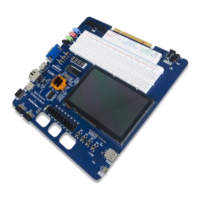6 | ni.com | NI Digital System Development Board User Manual
Power Supplies
The DSDB is powered from the NI ELVIS platform or an external power supply connected to
J17 (when used as a standalone platform). Connector J17 is placed in a way which doesn't allow
the connection of an external supply when the board is plugged into the NI ELVIS platform. This
was done to prevent the user from incorrectly attaching an external supply while the NI ELVIS
is powering the DSDB.
The NI ELVIS platform can deliver maximum 2 A of current on the 5 V output according to the
specifications. This should provide enough power for typical use. A typical application
represents a Zynq configuration that uses all on-board peripherals, 0.2 A load on each of the two
user supplies (5 V and 3.3 V), mouse connected to the USB HID port (J9), and analog outputs
in the MXP connector (J4) left floating. If more features are intended to be used, for example
drawing more power from the user supplies, a power demanding FPGA configuration, or
connecting a USB device that needs more than 100 mA, the DSDB board should be used as
standalone with an external power supply.
When used as a standalone platform an external power supply should be used by plugging into
the power jack (J17). The supply must use a coax, center-positive 2.1 mm internal-diameter
plug, and deliver 4.6 VDC to 5.5 VDC and at least 2 A of current (that is, at least 12.5 W of
power) for typical use cases and 4 A (20 W of power) for power demanding applications.
Suitable supplies can be purchased from the Digilent website or through catalog vendors like
DigiKey. Power supply voltages outside the above range will prevent the board from powering
up, while voltages above 18 V will cause permanent damage.
All on-board power supplies are enabled or disabled by the power switch (SW9). The power
indicator LED (LD14) is on when all the supply rails reach their nominal voltage. An overview
of the power circuit is shown in Figure 3.

